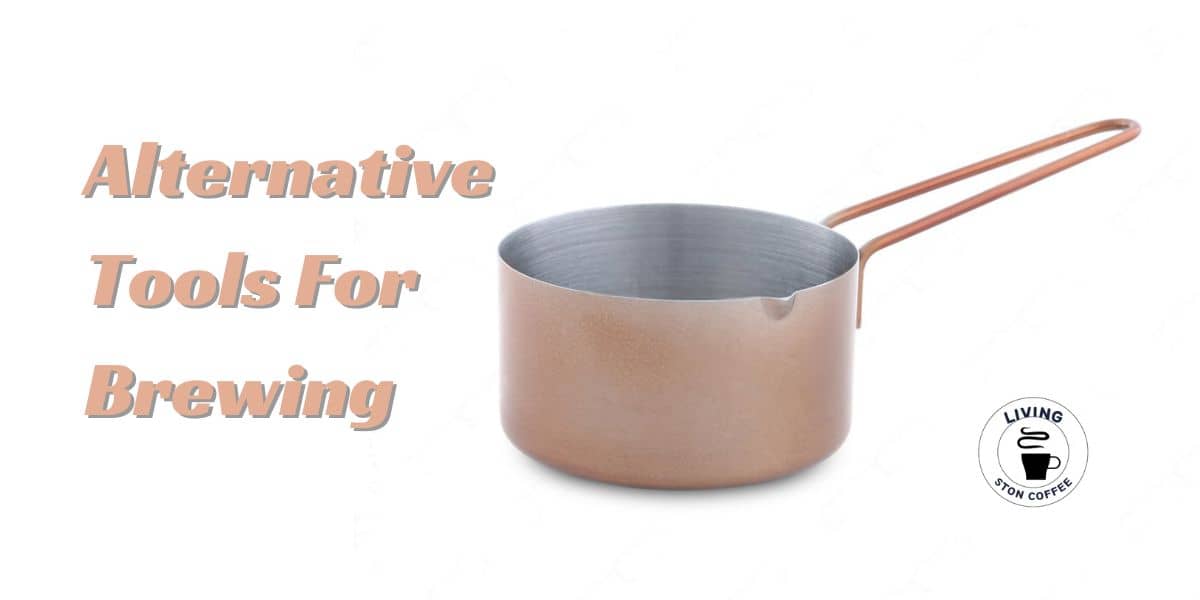To make Turkish coffee without an ibrik, use a small saucepan to simmer coffee, water, and sugar. Stir gently until foam forms before serving.
Introduction
Turkish coffee is renowned for its robust flavor and rich tradition, offering a unique experience to coffee enthusiasts. Typically prepared in a special pot called an ibrik or cezve, its preparation is considered an art form. However, coffee lovers need not despair if they don’t own this traditional equipment.
By using a common kitchen tool like a small saucepan, it’s still possible to create this distinctive brew right at home. This method maintains the essential elements of Turkish coffee: fine grounds, cold water, and the optional addition of sugar, all combined to capture the essence of this cultural staple. Careful attention to detail ensures that the key characteristics of Turkish coffee — strong aroma and frothy top — are preserved, making sure that the experience is authentic, even without an ibrik.
The Allure Of Turkish Coffee
Turkish coffee delights senses with its rich aroma and robust flavor. Its unique preparation and presentation turn coffee into an art. This beverage does not merely wake you up; it immerses you in a tradition that dates back centuries. Let’s explore the captivating world of Turkish coffee, even without an ibrik.
The Cultural Significance
- Social gatherings: Friends and family bond over Turkish coffee.
- Fortune-telling: Cups reveal future tales once sipped.
- Wedding customs: Grooms test with salted coffee.
Traditional Preparation Methods
Time-honored Turkish coffee techniques call for specific steps. First, fine ground coffee mixes with cold water and sugar. Heat slowly stirs the blend. A frothy top forms, signaling perfection. This process is usually done in an ibrik, a traditional coffee pot.
- Grind coffee: Achieve powder-like consistency.
- Water to coffee ratio: Use cold water, one cup per spoon of coffee.
- Add sugar: Blend to taste before heating.
- Slow heat: Patience ensures flavors develop.
- Watch for froth: Look for the rich crema on top.
Understanding The Ibrik’s Role
The iconic Turkish coffee, rich and aromatic, has a unique preparation method that often involves an ibrik. Yet, don’t let the absence of one stop you. Understanding how the ibrik functions can lead to alternative brewing approaches that honor the essence of Turkish coffee.
Design And Function Of An Ibrik
The ibrik, also known as a cezve, stands out with its design. It sports a wide bottom, a narrow neck, and a long handle. This form serves a purpose: precise heat control. When brewing Turkish coffee, the ibrik’s shape allows for a slow and even cook. This is essential to capture the coffee’s full flavor without boiling it.
Let’s decode its parts:
- Wide bottom: Spreads the coffee grounds for even heat.
- Narrow neck: Keeps the coffee from spilling and helps foam form.
- Long handle: Protects hands from heat and offers control during pouring.
Ibrik Vs. Other Coffee Pots
An ibrik is special but not without alternatives. Other pots can step in, like saucepans or small pots. Aim for a similar size to manage heat properly. A non-metallic pot can mimic the ibrik’s gentle heat conductance. Use a lid to trap steam if needed.
Consider these comparison points:
| Pot Type | Heat Control | Foam Formation | Ease of Pouring |
|---|---|---|---|
| Ibrik | Excellent | Optimal | Effortless |
| Saucepan | Good with attention | Manageable | Use a ladle or small cup |
| Small Pot | Good with attention | Manageable | Use a ladle or small cup |
Alternative Tools For Brewing
Craving the rich taste of Turkish coffee but don’t have an ibrik? Fear not! You can still brew a delicious cup using alternative tools found in your kitchen.
Selecting The Right Pot
To mimic the narrow top and wide bottom of a traditional ibrik, choose a small pot with similar features. Stainless steel or a small saucepan can work well. The key is to pick a pot that heats evenly and is easy to handle. A pouring spout is a bonus for when you serve your coffee without spilling.
Heat Source Considerations
- Select a heat source that allows control over the temperature. Turkish coffee requires a gentle simmer, not a rolling boil.
- Electric or gas stovetops are perfect. Use a heat diffuser if the flame is too strong.
- For single servings, consider a small flame. It gives you more control over the brewing.
- Remember, patience is key. Slow heating brings out the coffee’s best flavor.
Ready your favorite cup. Preheat it with some hot water while you begin the brewing process. This will ensure your Turkish coffee stays warm and comforting for as long as possible.
Coffee Bean Essentials
Diving into the heart of Turkish coffee, the beans take center stage. This unique brew relies on the right selection and preparation of coffee beans. Let’s explore how to perfect your Turkish coffee without an ibrik by nailing the coffee bean essentials.
Choosing The Right Beans
Arabica beans are the preferred choice for Turkish coffee. Look for beans from Brazil or Ethiopia for authentic flavor. The beans should display a rich and fresh aroma. They need to be high-quality, as Turkish coffee magnifies the beans’ qualities. Choose medium or dark roast to enjoy the coffee’s traditional robustness.
Grinding To The Ideal Fineness
Turkish coffee requires an ultra-fine grind. A powder-like consistency is ideal. This fineness surpasses that of espresso. It ensures a full extraction of flavor when brewed. Use a burr grinder for uniformity. Aim for a consistency similar to flour. For a perfect grind without a commercial grinder, a high-quality home grinder can suffice. The right grind is crucial for the signature thick, velvety foam atop a perfect cup of Turkish coffee.
- Select Arabica beans for rich flavor.
- Choose medium to dark roast for depth.
- Aim for a powder-like grind for the best brew.
- Use a high-quality grinder for consistency.
Creating The Perfect Blend
Welcome to the art of making Turkish coffee without an ibrik! Crafting the perfect blend of Turkish coffee is an experience that tantalizes the senses. With the right approach, it’s possible to enjoy this delectable brew even without the traditional tools. Let’s explore how to blend water, sugar, and spices into a perfect Turkish delight.
The Importance Of Water Quality
Quality water is vital for brewing Turkish coffee. It accounts for most of your cup. Use freshly drawn, cold water for the best taste. Hard water can affect the coffee’s flavor, so consider using filtered water if necessary. Soft water is preferable as it allows coffee’s true profile to shine.
Getting The Sugar And Spices Right
Sugar and spices give Turkish coffee its unique character. Adjust sugar to taste: none for unsweetened, a little for slightly sweet, and more for sweet. Common spices like cardamom and cinnamon elevate the coffee. Always grind spices fresh for a vigorous flavor.
| Type | Sugar Level | Spices |
|---|---|---|
| Plain | None (0g) | Optional |
| Medium | Moderate (5-10g) | Cardamom/Cinnamon |
| Sweet | High (>10g) | Cardamom/Cinnamon |
To summarize, select clean water and tailor sugar and spices for an exquisite Turkish coffee experience. These steps secure a brew that is not just a drink, but a journey for the palate. Embrace the process and indulge in a cup of cultural richness.
Step-by-step Without An Ibrik
Welcome to the aromatic world of Turkish coffee, even if an Ibrik isn’t at hand! Fear not, a traditional Turkish coffee pot – an Ibrik or cezve – isn’t the only way to brew this rich, delightful beverage. With some simple household tools, anyone can recreate the magic of Turkish coffee. Let’s dive into the step-by-step guide to making Turkish Coffee without an Ibrik.
Combining Ingredients
To start, gather your ingredients:
- High-quality, finely ground Turkish coffee
- Fresh, cold water
- Sugar (optional)
- A small pot or saucepan
- A spoon for stirring
Next, combine these in the small pot:
- For each cup, use one heaping tablespoon of coffee.
- Add a cup of cold water to the pot.
- Include sugar to taste (typically one to two teaspoons per cup).
Do not start heating yet. Stir the mixture until it is smooth.
Monitoring The Brewing Process
Place your pot on a low heat source. This step requires full attention. The coffee must never boil. Instead, seek a gentle simmer.
As a frothy layer begins to form, reduce heat. The key is to allow this foam to rise without spilling over.
Once the foam rises to the rim, remove the pot from the heat source. Let it rest for about thirty seconds. This allows the grounds to settle.
Repeat the heating process two more times. A total of three foaming phases ensures optimal flavor.
Serve the coffee immediately after the third rise. Pour it carefully into cups. The goal is to keep as much froth as possible.
Enjoy your homemade Turkish coffee with authentic taste and texture!
Pouring And Serving Authenticity
Crafting Turkish coffee without an ibrik is an art, capturing the essence of tradition in every cup. Authenticity lies in the details: the slow pour, the frothy top layer, and the cultural presentation. Let’s master these nuances together.
Achieving The Frothy Top Layer
The hallmark of a well-made Turkish coffee is its rich, creamy froth. Create this without an ibrik by carefully watching your pot. Use low heat and a consistent hand. As the coffee warms, a ring of tiny bubbles forms. This is your cue.
- Watch for bubbles around the edge.
- Stir gently to disperse the heat.
- Remove from heat just before boiling.
- Pour slowly to retain froth.
Pour the coffee into cups, letting the froth settle on top. Each cup must have a share of froth—a sign you’ve done it right.
Presentation And Traditional Cups
Turkish coffee is as much about experience as it is about taste. Serve it in traditional cups—small, porcelain, with ornate designs. They’re key for an authentic touch.
| Cup Material | Why It Matters |
|---|---|
| Porcelain | Holds heat, enhances flavor |
| Design | Reflects heritage, invites enjoyment |
Remember to pair your coffee with a glass of water and something sweet. Light bites cleanse the palate, readying you for the next sip of this ages-old brew.
Cleaning Up And Maintaining Utensils
Cleaning Up and Maintaining Utensils after brewing Turkish Coffee without an Ibrik is essential. A clean setup ensures every cup brewed maintains the rich flavor unique to Turkish coffee. Proper maintenance can also prolong the life of the tools you use. Let’s dive into the specifics of cleaning and upkeep.
Post-brew Cleanup
Once the last sip of your aromatic Turkish coffee settles, cleanup begins. Residue can be stubborn, but timely care makes it manageable.
- Empty grounds immediately to prevent caking.
- Rinse the saucepan or pot with warm water, avoiding harsh chemicals that can leave behind unwanted flavors.
- To remove coffee oils, use a mild dish soap and a soft sponge.
- Dry your utensils thoroughly with a clean towel to avoid water spots or rust, especially if using metal pots.
Maintaining Non-ibrik Tools
Continuous care extends your tools’ lifespans. Here are easy-to-follow steps:
- Store equipment in a dry place to fend off moisture-induced damage.
- Regularly check for wear, such as cracks in your heat-proof spoon or the pot’s handle.
- Keep up with buffer cleaning, using vinegar or baking soda for deeper cleans.
- Periodically descale your kettle if you use one, preventing mineral buildup.
With these tips, your Turkish coffee ritual will always be a clean, delicious experience.
Experimenting With Variations
Tapping into the rich tradition of Turkish coffee brewing can be a delightful adventure, even in the absence of an ibrik. Venturing into the realm of Experimenting with Variations allows for creativity in your coffee preparation. Adjusting the flavor to match personal preferences or adding unique touches turns each cup into a personalized experience.
Adjusting Flavor Profiles
Unlock a world of sensory delight by tweaking the coffee’s flavor. Personalize each cup to your taste by exploring these suggestions:
- Control the coffee’s strength by varying the quantity of coffee grounds.
- Alter sweetness by experimenting with different types of sugar, such as brown or demerara.
- Experiment with spices like cardamom, cinnamon, or nutmeg for a unique twist.
Infusing Personal Touches
Your Turkish coffee should resonate with your personal style. Here are a few ways to leave your mark:
| Personal Touch | Method |
|---|---|
| Aromatic Infusions | Add rosewater or orange blossom water for a floral hint. |
| Creamy Richness | Stir in a spoonful of cream or condensed milk post-brewing. |
| Texture Play | Top with a dollop of whipped cream or foam for a luxurious feel. |
Combining these elements brings a new dimension to your Turkish coffee. Each sip echoes your individuality, transforming the traditional into something distinctly yours.
Turkish Coffee Trivia
Welcome to ‘Turkish Coffee Trivia,’ where we dive into the rich history and culture surrounding this beloved beverage. Turkish coffee is much more than just a drink; it’s a tradition that has been passed down through generations. We’ll explore some fun facts and bust common myths, all without the need for an ibrik. So grab a cup and let’s get brewing!
Fun Facts About Turkish Coffee
- Turkish coffee is a UNESCO Intangible Cultural Heritage of Humanity.
- It’s famous for its unique preparation and serving style.
- Fortune telling with coffee grounds is a popular pastime in Turkey.
Common Myths Debunked
Let’s clear up some misconceptions:
| Myth | Truth |
|---|---|
| Turkish coffee is extremely bitter. | It can be sweetened; the taste depends on the amount of sugar added. |
| You can’t make it without an ibrik. | There are alternative methods with similar results. |
| It’s a specific bean or blend. | Any coffee bean can be used; it’s all about the grind and prep. |
Frequently Asked Questions Of How To Make Turkish Coffee Without An Ibrik?
How Do You Make Turkish Coffee Without Ibrik?
To make Turkish coffee without an ibrik, use a small saucepan. Combine fine coffee grounds with cold water and sugar if desired. Stir over low heat until foam rises, then serve immediately. Avoid boiling to preserve the distinct foam.
Do You Need A Cezve To Make Turkish Coffee?
Yes, a cezve is traditionally required to make Turkish coffee as it allows proper mixing and heat distribution essential for authentic taste.
Can You Make Turkish Coffee From Normal Coffee?
Yes, you can use finely ground normal coffee to make Turkish coffee, but traditional Turkish blends offer a unique flavor.
Can You Make Turkish Coffee Without Sugar?
Yes, you can make Turkish coffee without sugar. Simply omit the sugar during preparation to enjoy a stronger, unsweetened taste.
Final Thought
Crafting a delicious Turkish coffee at home is absolutely possible, even without the traditional ibrik. By following the alternative methods outlined, you can indulge in this rich, aromatic beverage anytime. So, grab your pan or espresso maker, and savor the unique taste of Turkish coffee, right from your own kitchen.
Cheers to your next coffee adventure!




